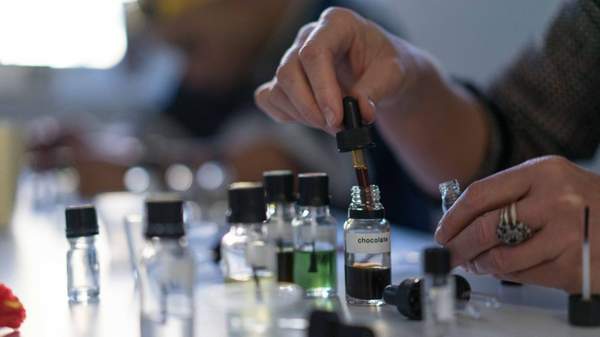Overview
The art of selecting the perfect fragrance is something that has stumped scent-crossed lovers for centuries. Chiefly, because a bouquet has the ability to produce counter reactions like attraction or revulsion. While sniffing paper rectangles smothered in celebrity endorsed aqua is the typical way to find your scent, there are other more meaningful ways to shop for smells.
Creating a fragrance from scents forged and found in nature is one particular avenue. Perfume Playground is the first-of-its kind scent lab that allows guests to play around with natural scents from over 100 raw materials and blend them together into wearable art. The interactive classes also take the process one step further by encouraging its members to use the power of scent to create better experiences for themselves, connecting scent with science and the natural world to enhance their wellbeing.
To find out more about natural perfumery we sat down with Perfume Playground founder Samantha Copland.
Hi Samantha. What is natural perfumery?
I like to think of natural perfumery as biodynamic beauty, or aromatic art. With links to nature, alchemy and ritual natural perfumery has aesthetic and therapeutic benefits; it's beauty and wellness in one.
What's the difference between aromatherapy, natural perfume and synthetic perfume?
While natural and synthetic perfume are designed for beauty, aromatherapy's primary care is to benefit the wearer therapeutically. While the typical natural perfume might have about 9 to 30 ingredients, synthetics have over 50 and aromatherapy blends may have as little as 5. Naturals might not last as long on the skin, but the more you experience them the more you feel their transformative power.
Why doesn't natural perfume last as long?
On average, mainstream fragrances are composed of about 80% synthetic aromachemicals, often chosen for their lower cost and higher availability. Natural fragrances aren't as intense as mainstream perfumes. If the perfume lasts more than a few hours, is tenacity is most likely because of chemicals. The secret to longer-lasting natural fragrance is layering it on the skin, using different forms of the same fragrance, like a solid perfume, but it varies from person to person.
Why does natural perfume cost more?
Real plant scents are luxurious, deep and complex; they've therapeutic qualities while synthetics don't. Natural perfumes are made in small batches by hand, they're dynamic.
How do I know if a perfume is truly all natural?
If you find a low cost natural perfume that claims that it has expensive ingredients in it like orris or narcissus then it's likely the ingredients have been adulterated. Geranium and Patchouli are often treated and blended with inferior oils.
We heard that essential oils can be used in food and cocktails?
It's easy to start incorporating essential oils into daily life, food and drink especially. You might dilute some sweet basil essential oil in your next Tom Collins. It's best to add the oil one drop at a time as essential oils differ in intensity and strength. If you add the essential oil into the sugar syrup, and then add that to your cocktail mix you'll be able to control the strength of the sweet basil flavour. If you're making an indian curry, you could equally add some cinnamon essential oil to your melting ghee and onions as fats fixes flavour really well.
What are the methods of extracting essential oils?
There are two key methods for essential oils; expression and distillation. Expression (or cold pressing) is the oldest and more simple method and citrus essential oils like lemon, bergamot, sweet orange, lime and tangerine.
You may have pressed the rind of fruit between your fingers, breaking up the essential oil cavities. The process is done with larger scale machines now that prod, prick and stick at the zest, but in older times, a large sponge would press the rind and absorb the essential oil, before being pressed over a container forcing a separation between the oil and the water/juice.
Distillation uses water and steam or a combination of both to extract an essence. Plant material is put into a still and the steam drives the volatile parts of the botanic material to rise up, leading them through a condenser which cools the vapor back into liquid form. The captured essence generally rises to the top so it can be then separated.
Very delicate flowers like jasmine, gardenia and mimosa are processed through enfleurage or more commonly solvent extraction to form absolutes which are highly concentrated aromatics. Solvent extraction makes use of solvents like petroleum to form thick, waxy substances of odoriferous plant material and fat, known as a concrete. When the concrete is mixed with alcohol, a concentrated aromatic or absolute is rendered.
Perfume Playground runs bespoke fragrance classes from Auckland to Sydney and San Francisco. Find out more at, www.perfumeplayground.co
